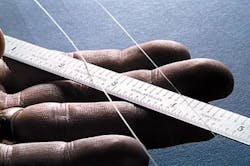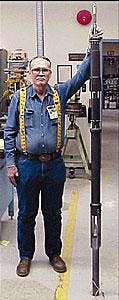Gas Technology Institute (GTI), Des Plaines, Ill., has signed a deal with an unnamed oil-field service company to develop further and commercialize a disposable fiber-optic telemetry system for the drilling industry, according to GTI business development director Ed Smalley.
The telemetry system would apply to measurement-while-drilling (MWD) and logging-while-drilling (LWD) applications on conventional drilling rigs with conventional drill pipe, without interfering with drilling operations, according to GTI.1
With the reward of data transfer rates as high as 1 million bits/sec, commercialization of the fiber-optic technology seeks to leapfrog the industry's current MWD telemetry, which is based primarily on communication through mud-pulses that yield data transfer rates of only 1-10 bits/sec.
Smalley said that researchers from Sandia National Laboratory (SNL), Albuquerque, and GTI have developed and tested a bare bones, proof-of-concept system, but not a commercial product that is ready for field use.
The licensee will likely have to commit a multimillion dollar investment over the next 2 years to yield a commercial system that it can introduce to the industry.
Development, testing
GTI reported that David Holcomb, an SNL researcher, came up with the idea for disposable fiber-optics telemetry at a 1990 Society of Petroleum Engineers' forum in Colorado.1
Panelists, during one of the sessions, highlighted the need for technology to transmit data from downhole to support a video system without interfering with drilling operations.
Current technology for high data-rate measurements, such as a video system or openhole logging, requires the operator to stop drilling, pull the drill pipe, and lower the measurement and telemetry instruments into the wellbore, a process that can be extremely expensive.
According to GTI, Holcomb thought of a defense research topic-a missile-guidance system that uses heavily armored disposable fiber-optic coils that rapidly unwind from missile-mounted canisters.
Rather than using the heavily armored fiber as a wireline, however, he considered using the unarmored fiber as a throwaway item, for one-time use (Fig. 1). He developed the idea through an $80,000 grant from SNL in the early 1990s and his work answered the basic research questions.
The technology remained dormant until 1999, when GTI championed the fiber-optic telemetry system. GTI acquired the patent and earmarked $1.3 million to fund proof-of-concept research, over the next 3 years, in partnership with SNL.
Gas Technology Institute and Sandia National Laboratory developed a high bandwidth, fiber-optic telemetry system for the drilling environment. A laboratory technician stands next to the unit, which weighs less than 100 lb, measures about 10 ft in length, and can deliver data transfer rates as high as 1 million bits/sec (Fig. 2). Photo courtesy of Gas Technology Institute.
According to GTI, the research culminated in successful field tests at the Catoosa Test Facility in Oklahoma in September 2000.
The fiber-optic system delivered downhole data to surface at 500,000 bits/sec, without stopping the drilling operation.
Researchers had two major concerns going into the tests that turned out to be inconsequential: abrasiveness and drag. Abrasive particles had no adverse effects on the light plastic fiber coating.
GTI said that flow turbulence and the resulting drag on the optical fiber proved less of a problem than originally estimated.
The fiber tended to move to the wall of the drillstring and away from the mudflow.
While the fiber-optic line was only tested to 3,000 ft during the field tests, researchers have reported that they see no obstacle to reaching ultimate depths of 20,000 ft.
Commercialization
GTI said that further development of the concept will likely lead to design changes, including a slack-control mechanism for the fiber-optic cable to prevent kinking of the optical fibers during deployment and data collection.
The licensee will probably maintain flexibility of the current system, which allows the addition of more lengths of drill pipe without significant interruptions to drilling operations.
Once MWD or LWD data collection operations have been completed, the commercially refined telemetry system must have an effective way to grind up the optical fibers and flush the debris out of the drillstring with the drilling mud.
This, according to Smalley, is one of the main commercialization challenges for the licensee.
Access to high rate, real-time data could lead to new markets in MWD and LWD, according to GTI. This would bring significant changes to how wells are drilled and evaluated, and would likely spawn a whole new generation of previously unimagined measuring instruments.
GTI says it estimates those markets exceed $1 billion/year, which could become much larger if customers could purchase high-data-rate, real-time downhole measurements, such as formation imaging, nuclear magnetic resonance, and seismic data.
Reference
- Szeremet, M., "The Final Frontier: Fiber Optics Promise Real-Time Information on Well Drilling," GTI Journal, Vol. 25 (2002), No. 1, passim.





